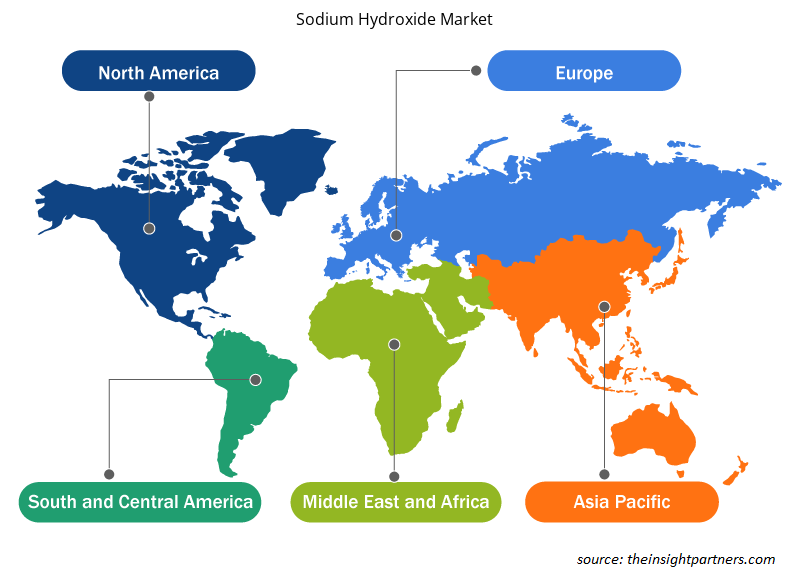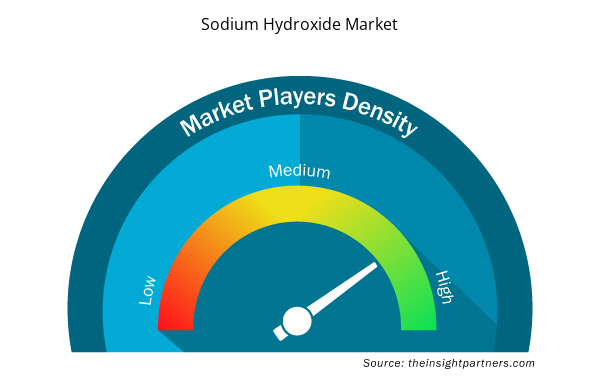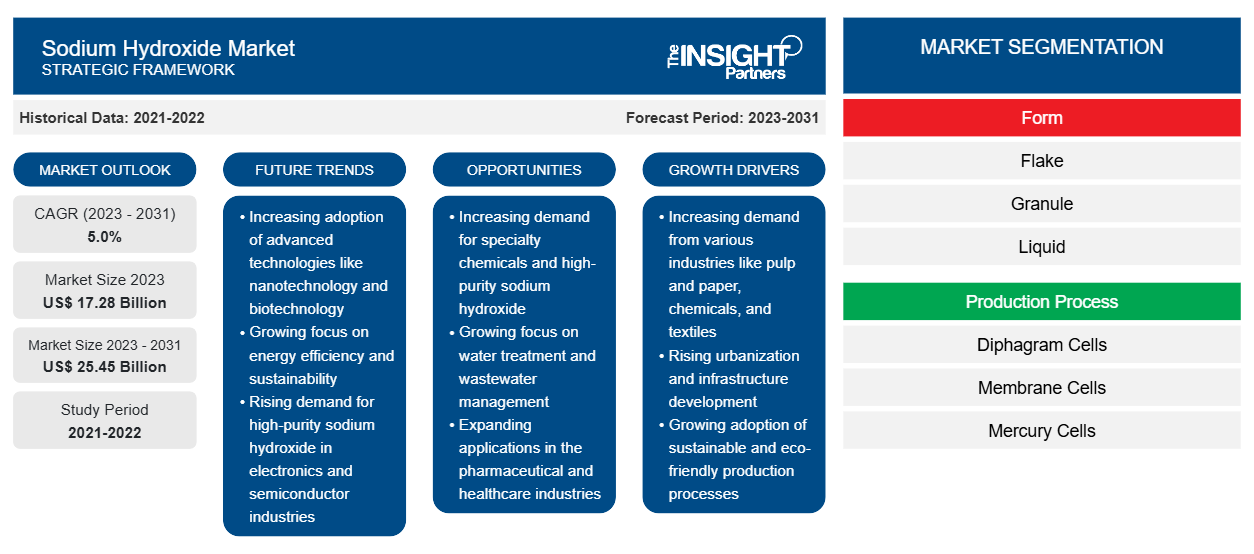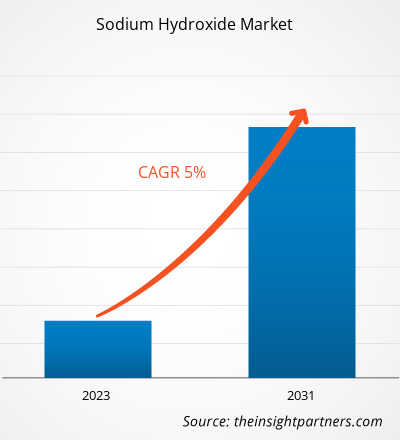Der Markt für Natriumhydroxid soll von 17,28 Milliarden US-Dollar im Jahr 2023 auf 25,45 Milliarden US-Dollar im Jahr 2031 anwachsen. Der Markt soll in den Jahren 2023–2031 eine durchschnittliche jährliche Wachstumsrate (CAGR) von 5,0 % verzeichnen. Die steigende Nachfrage aus Endverbrauchsbranchen wie Zellstoff und Papier, Körperpflege, Pharmazie und Wasseraufbereitung dürfte ein wichtiger Trend auf dem Natriumhydroxid-Markt bleiben.
Natriumhydroxid-Marktanalyse
In der Lebensmittelindustrie wird Ätznatron bei der Lebensmittelverarbeitung, als pH-Regulator und bei der Herstellung bestimmter Produkte wie Oliven und Brezeln verwendet. In der Körperpflegeindustrie wird Natriumhydroxid bei der Seifenherstellung verwendet. Natriumhydroxid ist ein wichtiger Bestandteil des Verseifungsprozesses. In diesem Prozess reagiert Natriumhydroxid mit natürlichen Ölen oder Fetten wie Kokos- oder Olivenöl und bildet Seife. Diese Reaktion verwandelt diese Öle in Seifenstücke oder Flüssigseifen. Natriumhydroxid hilft auch, den pH-Wert anzupassen. Natriumhydroxid bestätigt auch, dass das Endprodukt sicher für die Anwendung auf der Haut ist und wirksame Reinigungseigenschaften aufweist. Darüber hinaus wird Natriumhydroxid zur Herstellung verschiedener Haarpflegeprodukte verwendet. Es wird auch bei der Herstellung von Dauerwellen, Haarglättern und Haarglättungsprodukten verwendet . Natriumhydroxid hilft, die Disulfidbindungen im Haar aufzubrechen. Dies hilft bei der Umformung oder Restrukturierung der Haarfasern. Dieser Prozess ist entscheidend, um die gewünschten Frisuren zu erzielen. Die steigende Beliebtheit verschiedener Haarstylingprodukte und anderer Körperpflegeprodukte treibt die Nachfrage nach Natriumhydroxid im Herstellungsprozess dieser Produkte an.
Natriumhydroxid Marktübersicht
Natriumhydroxid wird häufig bei der Herstellung von Polymeren verwendet. Polycarbonat ist ein thermoplastischer Kunststoff, der für seine optische Klarheit und Schlagfestigkeit bekannt ist und durch Polymerisation mit Natriumhydroxid hergestellt wird. Bei dieser Herstellung wird Natriumhydroxid als Katalysator verwendet, um die Reaktion zwischen Bisphenol A und Phosgen zu beschleunigen und Polycarbonatketten zu bilden . Das Ergebnis ist ein vielseitiges Material, das in zahlreichen Branchen verwendet wird, darunter Automobil, Optik und Elektronik. Darüber hinaus wird Natriumhydroxid auch in Polypropylenoxid (PPO) verwendet, wo es als Katalysator im Polymerisationsprozess fungiert und eine PPO-Kette aus Propylenoxidmonomeren bildet. Das resultierende Polymer wird in verschiedenen Spezialanwendungen eingesetzt und weist eine außergewöhnliche chemische Beständigkeit auf, was das Wachstum des Natriumhydroxidmarktes vorantreibt.
Passen Sie diesen Bericht Ihren Anforderungen an
Sie erhalten kostenlos individuelle Anpassungen an jedem Bericht, einschließlich Teilen dieses Berichts oder einer Analyse auf Länderebene, eines Excel-Datenpakets sowie tolle Angebote und Rabatte für Start-ups und Universitäten.
- Holen Sie sich die wichtigsten Markttrends aus diesem Bericht.Dieses KOSTENLOSE Beispiel umfasst eine Datenanalyse von Markttrends bis hin zu Schätzungen und Prognosen.
Natriumhydroxid-Markttreiber und -Chancen
Steigende Nachfrage aus der Textilindustrie stärkt Wachstum auf dem Natriumhydroxid-Markt
Die Textilindustrie ist ein bedeutender Anwendungsbereich des Natriumhydroxidmarktes. In der Textilindustrie wird es im Mercerisierungsprozess verwendet. Mercerisierung ist ein Behandlungsprozess, der bei Zellulosefasern wie Baumwolle angewendet wird, um deren Eigenschaften zu verbessern. Bei diesem Prozess werden Baumwollfasern mit einer NaOH-Lösung behandelt, die die Fasern aufquellen lässt, was zu mehr Glanz, Festigkeit und Farbaufnahme führt. Durch die Mercerisierung werden die Gesamtqualität und das Erscheinungsbild von Baumwolltextilien verbessert, sie werden glatter und aufnahmefähiger für Farbstoffe und Veredelungen.
Zunehmende Akzeptanz in der Pharmaindustrie
In der Pharmaindustrie dient es als wichtiges Reagenz bei der Synthese pharmazeutischer Verbindungen. Es wird in verschiedenen Phasen der pharmazeutischen Produktion verwendet, einschließlich der Synthese von aktiven pharmazeutischen Inhaltsstoffen (APIs) und der Formulierung von Arzneimitteln. Bei der API-Synthese wird es eingesetzt, um den pH-Wert anzupassen, chemische Reaktionen zu erleichtern oder die Löslichkeit bestimmter Arzneimittelkomponenten zu kontrollieren. Seine präzise Verwendung trägt dazu bei, die Wirksamkeit und Sicherheit pharmazeutischer Produkte zu gewährleisten und das Wachstum des Natriumhydroxid-Marktes weiter voranzutreiben.
Natriumhydroxid-Marktbericht – Segmentierungsanalyse
Wichtige Segmente, die zur Ableitung der Natriumhydroxid-Marktanalyse beigetragen haben, sind Form, Produktionsprozess und Endverbrauchsindustrie.
- Basierend auf der Form ist der Markt in Flocken, Granulate und Flüssigkeiten unterteilt. Das Flüssigkeitssegment hatte im Jahr 2023 einen größeren Marktanteil.
- In Bezug auf den Produktionsprozess ist der Markt in Diphagramzellen, Membranzellen und Quecksilberzellen segmentiert. Das Segment der Membranzellen hatte im Jahr 2023 den größten Marktanteil.
- Auf der Grundlage der Endverbrauchsindustrie ist der Markt in Zellstoff und Papier, Körperpflege, Pharmazeutika, Wasseraufbereitung, Textilien, Lebensmittel und andere unterteilt. Das Segment Zellstoff und Papier hatte im Jahr 2023 den größten Marktanteil.
Natriumhydroxid Marktanteilsanalyse nach Geografie
Der geografische Umfang des Natriumhydroxid-Marktberichts ist hauptsächlich in fünf Regionen unterteilt: Nordamerika, Asien-Pazifik, Europa, Naher Osten und Afrika sowie Süd- und Mittelamerika.
Der asiatisch-pazifische Raum hat sich zu einem globalen Produktionszentrum entwickelt, dessen Industrien von der Chemie über die Textil- bis hin zur Zellstoff- und Papierindustrie reichen. Der asiatisch-pazifische Raum erlebte eine rasante Industrialisierung und Urbanisierung. Viele chemische Prozesse, wie die Herstellung von Kunststoffen, Reinigungsmitteln und verschiedenen Industriechemikalien, sind auf diese Chemikalie als entscheidenden Rohstoff angewiesen. Aufgrund der starken Präsenz des asiatisch-pazifischen Raums im Chemiesektor und seines Engagements für Forschung und Innovation ist die Nachfrage nach dieser Chemikalie gestiegen, um diese Industrien zu unterstützen.
Regionale Einblicke in den Natriumhydroxid-Markt
Die regionalen Trends und Faktoren, die den Natriumhydroxid-Markt im Prognosezeitraum beeinflussen, wurden von den Analysten von Insight Partners ausführlich erläutert. In diesem Abschnitt werden auch die Natriumhydroxid-Marktsegmente und die Geografie in Nordamerika, Europa, im asiatisch-pazifischen Raum, im Nahen Osten und Afrika sowie in Süd- und Mittelamerika erörtert.

- Holen Sie sich die regionalen Daten für den Natriumhydroxid-Markt
Umfang des Natriumhydroxid-Marktberichts
| Berichtsattribut | Details |
|---|---|
| Marktgröße im Jahr 2023 | 17,28 Milliarden US-Dollar |
| Marktgröße bis 2031 | 25,45 Milliarden US-Dollar |
| Globale CAGR (2023 - 2031) | 5,0 % |
| Historische Daten | 2021-2022 |
| Prognosezeitraum | 2023–2031 |
| Abgedeckte Segmente | Nach Formular
|
| Abgedeckte Regionen und Länder | Nordamerika
|
| Marktführer und wichtige Unternehmensprofile |
|
Marktteilnehmerdichte für Natriumhydroxid: Auswirkungen auf die Geschäftsdynamik verstehen
Der Markt für Natriumhydroxid wächst rasant, angetrieben durch die steigende Nachfrage der Endverbraucher aufgrund von Faktoren wie sich entwickelnden Verbraucherpräferenzen, technologischen Fortschritten und einem größeren Bewusstsein für die Vorteile des Produkts. Mit steigender Nachfrage erweitern Unternehmen ihr Angebot, entwickeln Innovationen, um die Bedürfnisse der Verbraucher zu erfüllen, und nutzen neue Trends, was das Marktwachstum weiter ankurbelt.
Die Marktteilnehmerdichte bezieht sich auf die Verteilung der Firmen oder Unternehmen, die in einem bestimmten Markt oder einer bestimmten Branche tätig sind. Sie gibt an, wie viele Wettbewerber (Marktteilnehmer) in einem bestimmten Marktraum im Verhältnis zu seiner Größe oder seinem gesamten Marktwert präsent sind.
Die wichtigsten auf dem Natriumhydroxid-Markt tätigen Unternehmen sind:
- Vynova-Gruppe
- Vencorex
- Tessenderlo-Gruppe
- Kaustik Europe BV
- Nobian Industrial Chemicals BV
- Aditya Birla Gruppe
Haftungsausschluss : Die oben aufgeführten Unternehmen sind nicht in einer bestimmten Reihenfolge aufgeführt.

- Überblick über die wichtigsten Akteure auf dem Natriumhydroxid-Markt
Neuigkeiten und aktuelle Entwicklungen zum Natriumhydroxid-Markt
Der Natriumhydroxidmarkt wird durch die Erhebung qualitativer und quantitativer Daten nach Primär- und Sekundärforschung bewertet, die wichtige Unternehmensveröffentlichungen, Verbandsdaten und Datenbanken umfasst. Im Folgenden finden Sie eine Liste der Entwicklungen auf dem Natriumhydroxidmarkt und der Strategien:
- Gujarat Alkalies and Chemicals Limited hat im Einklang mit seinen Wachstumsplänen die Natronlaugenanlage seines Dahej-Komplexes von 785 MTPD auf 1310 MTPD erweitert. Im Rahmen der Natronlaugenerweiterung wurde auch eine neue 700 MTPD-Laugenverdampfungseinheit (CEU) in Betrieb genommen, um den Bedarf an Natronlaugenproduktion (48 % w/w) zu decken. (Quelle: Gujarat Alkalies and Chemicals Limited, Pressemitteilung, 2023)
Marktbericht zu Natriumhydroxid – Umfang und Ergebnisse
Der Bericht „Marktgröße und Prognose für Natriumhydroxid (2021–2031)“ bietet eine detaillierte Analyse des Marktes, die die folgenden Bereiche abdeckt:
- Marktgröße und Prognose auf globaler, regionaler und Länderebene für alle wichtigen Marktsegmente, die im Rahmen des Projekts abgedeckt sind
- Marktdynamik wie Treiber, Beschränkungen und wichtige Chancen
- Wichtige Zukunftstrends
- Detaillierte Porter's Five Forces und SWOT-Analyse
- Globale und regionale Marktanalyse mit wichtigen Markttrends, wichtigen Akteuren, Vorschriften und aktuellen Marktentwicklungen
- Branchenlandschaft und Wettbewerbsanalyse, einschließlich Marktkonzentration, Heatmap-Analyse, prominenten Akteuren und aktuellen Entwicklungen
- Detaillierte Firmenprofile
- Historische Analyse (2 Jahre), Basisjahr, Prognose (7 Jahre) mit CAGR
- PEST- und SWOT-Analyse
- Marktgröße Wert/Volumen – Global, Regional, Land
- Branche und Wettbewerbsumfeld
- Excel-Datensatz



Report Coverage
Revenue forecast, Company Analysis, Industry landscape, Growth factors, and Trends

Segment Covered
This text is related
to segments covered.

Regional Scope
North America, Europe, Asia Pacific, Middle East & Africa, South & Central America

Country Scope
This text is related
to country scope.
Trends and growth analysis reports related to Chemicals and Materials : READ MORE..
The List of Companies
1. BASF SE
2. Bayer AG
3. Ciech S.A
4. Dow, Inc.
5. Formosa Plastics Corporation
6. Hanwha Solutions
7. INEOS
8. Kemira
9. SABIC
10. SOLVAY
The Insight Partners performs research in 4 major stages: Data Collection & Secondary Research, Primary Research, Data Analysis and Data Triangulation & Final Review.
- Data Collection and Secondary Research:
As a market research and consulting firm operating from a decade, we have published and advised several client across the globe. First step for any study will start with an assessment of currently available data and insights from existing reports. Further, historical and current market information is collected from Investor Presentations, Annual Reports, SEC Filings, etc., and other information related to company’s performance and market positioning are gathered from Paid Databases (Factiva, Hoovers, and Reuters) and various other publications available in public domain.
Several associations trade associates, technical forums, institutes, societies and organization are accessed to gain technical as well as market related insights through their publications such as research papers, blogs and press releases related to the studies are referred to get cues about the market. Further, white papers, journals, magazines, and other news articles published in last 3 years are scrutinized and analyzed to understand the current market trends.
- Primary Research:
The primarily interview analysis comprise of data obtained from industry participants interview and answers to survey questions gathered by in-house primary team.
For primary research, interviews are conducted with industry experts/CEOs/Marketing Managers/VPs/Subject Matter Experts from both demand and supply side to get a 360-degree view of the market. The primary team conducts several interviews based on the complexity of the markets to understand the various market trends and dynamics which makes research more credible and precise.
A typical research interview fulfils the following functions:
- Provides first-hand information on the market size, market trends, growth trends, competitive landscape, and outlook
- Validates and strengthens in-house secondary research findings
- Develops the analysis team’s expertise and market understanding
Primary research involves email interactions and telephone interviews for each market, category, segment, and sub-segment across geographies. The participants who typically take part in such a process include, but are not limited to:
- Industry participants: VPs, business development managers, market intelligence managers and national sales managers
- Outside experts: Valuation experts, research analysts and key opinion leaders specializing in the electronics and semiconductor industry.
Below is the breakup of our primary respondents by company, designation, and region:

Once we receive the confirmation from primary research sources or primary respondents, we finalize the base year market estimation and forecast the data as per the macroeconomic and microeconomic factors assessed during data collection.
- Data Analysis:
Once data is validated through both secondary as well as primary respondents, we finalize the market estimations by hypothesis formulation and factor analysis at regional and country level.
- Macro-Economic Factor Analysis:
We analyse macroeconomic indicators such the gross domestic product (GDP), increase in the demand for goods and services across industries, technological advancement, regional economic growth, governmental policies, the influence of COVID-19, PEST analysis, and other aspects. This analysis aids in setting benchmarks for various nations/regions and approximating market splits. Additionally, the general trend of the aforementioned components aid in determining the market's development possibilities.
- Country Level Data:
Various factors that are especially aligned to the country are taken into account to determine the market size for a certain area and country, including the presence of vendors, such as headquarters and offices, the country's GDP, demand patterns, and industry growth. To comprehend the market dynamics for the nation, a number of growth variables, inhibitors, application areas, and current market trends are researched. The aforementioned elements aid in determining the country's overall market's growth potential.
- Company Profile:
The “Table of Contents” is formulated by listing and analyzing more than 25 - 30 companies operating in the market ecosystem across geographies. However, we profile only 10 companies as a standard practice in our syndicate reports. These 10 companies comprise leading, emerging, and regional players. Nonetheless, our analysis is not restricted to the 10 listed companies, we also analyze other companies present in the market to develop a holistic view and understand the prevailing trends. The “Company Profiles” section in the report covers key facts, business description, products & services, financial information, SWOT analysis, and key developments. The financial information presented is extracted from the annual reports and official documents of the publicly listed companies. Upon collecting the information for the sections of respective companies, we verify them via various primary sources and then compile the data in respective company profiles. The company level information helps us in deriving the base number as well as in forecasting the market size.
- Developing Base Number:
Aggregation of sales statistics (2020-2022) and macro-economic factor, and other secondary and primary research insights are utilized to arrive at base number and related market shares for 2022. The data gaps are identified in this step and relevant market data is analyzed, collected from paid primary interviews or databases. On finalizing the base year market size, forecasts are developed on the basis of macro-economic, industry and market growth factors and company level analysis.
- Data Triangulation and Final Review:
The market findings and base year market size calculations are validated from supply as well as demand side. Demand side validations are based on macro-economic factor analysis and benchmarks for respective regions and countries. In case of supply side validations, revenues of major companies are estimated (in case not available) based on industry benchmark, approximate number of employees, product portfolio, and primary interviews revenues are gathered. Further revenue from target product/service segment is assessed to avoid overshooting of market statistics. In case of heavy deviations between supply and demand side values, all thes steps are repeated to achieve synchronization.
We follow an iterative model, wherein we share our research findings with Subject Matter Experts (SME’s) and Key Opinion Leaders (KOLs) until consensus view of the market is not formulated – this model negates any drastic deviation in the opinions of experts. Only validated and universally acceptable research findings are quoted in our reports.
We have important check points that we use to validate our research findings – which we call – data triangulation, where we validate the information, we generate from secondary sources with primary interviews and then we re-validate with our internal data bases and Subject matter experts. This comprehensive model enables us to deliver high quality, reliable data in shortest possible time.


 Holen Sie sich ein kostenloses Muster für diesen Bericht
Holen Sie sich ein kostenloses Muster für diesen Bericht